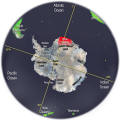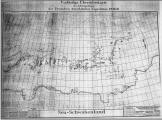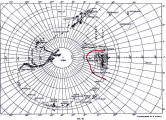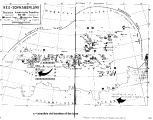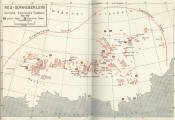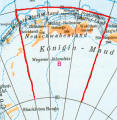|

by Erich J. Choron
from
GreyFalcon Website
In 1947, Admiral
Richard E. Byrd led 4,000
military troops from the U.S., Britain and Australia in an invasion
of Antarctica called “Operation Highjump”, and at least one
follow-up expedition.
That is fact. It is undeniable. But...
the part of the story that is seldom told, at least in “official”
circles, is that Byrd and his forces encountered heavy resistance to
their Antarctic venture from “flying saucers” and had to call off
the invasion.
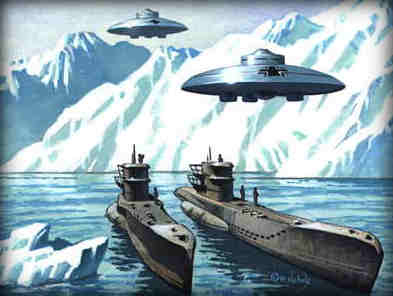
This aspect of the story was pushed
forward, again, a few years ago, when a retired Rear Admiral,
allegedly living in Texas, who had been involved in the “invasion”,
said he was “shocked” when he read material from a documentary,
entitled "Rire from the Sky".
He allegedly claimed that he knew
there had been “a lot of aircraft and rocket shoot-downs”, but did
not realize the situation was as serious as the documentary
presented it.
Operation “High Jump”, which was,
basically an invasion of the Antarctic, consisted of three Naval
battle groups, which departed Norfolk, VA, on 2 December 1946. They
were led by Admiral Richard E. Byrd’s command ship, the ice-breaker
“Northwind,” and consisted of the catapult ship “Pine Island,” the
destroyer “Brownsen,” the aircraft-carrier “Phillipines Sea,” the
U.S. submarine “Sennet,” two support vessels “Yankee” and “Merrick,”
and two tankers “Canisted” and “Capacan,” the destroyer “Henderson”
and a floatplane ship “Currituck.”
A British-Norwegian force and a Russian
force, and I believe some Australian and Canadian forces were also
involved.
Interestingly, the Pine Island (AV-12), one of the seaplane tenders
involved in the expedition, has a rather colorful history. The USS
Pine Island, a Currituck Class Seaplane Tender, was laid down, 16
November 1942, at Todd Shipyard Corporation, in San Pedro,
California. It was launched, 26 February 1944, and given the
commissioned name, USS Pine Island on 26 April 1945.
The ship served through the final months
of the Second World War, and the immediate post-war period, but was
decommissioned on 1 May 1950 When the Korean War broke out, the ship
was re-commissioned, on 7 October 1950, at Alameda, California. She
was finally decommissioned, for good, on 16 June 1967 and laid up in
the Reserve Fleet.
But... here’s where the story gets interesting... The USS Pine
Island was struck from the Naval Register, on an unknown date... Her
title was transferred to the Maritime Administration for lay up in
the National Defense Reserve Fleet... on an unknown date... and...
the ship’s final disposition is unknown... Now... how does one go
about “losing” a major surface ship, over 640 feet long, almost
seventy feet wide, with a displacement of over 15,000 tons? [see
Rejoinder
below]
|
Rejoinder:
As a federal employee with immediate access to the
NDRF (National Defense Reserve Fleet)
archives, which are all unclassified, let me provide
additional information as it relates to the subject
story of 3/15.
Mr. Choron states:
“The USS Pine Island was struck from
the Naval Register, on an unknown date... Her title was
transferred to the Maritime Administration for lay up in
the National Defense Reserve Fleet... on an unknown
date... and... the ship’s final disposition is
unknown... “
Here’s what I can tell you:
PINE ISLAND was delivered to Zidell Explorations in Portland, OR (now Zidell Marine)
on 3/7/72 under a standard scrapping contract. Zidell
paid $166K for the ship, which would be typical. In 1971
PINE ISLAND was towed to Bremerton to be stripped out by
the Navy, which is not uncommon for a ship to be
scrapped. The fact that she (nor the other AVs) is not
listed on the Naval Vessel Register is strange, but
probably just an oversight on the Navy’s part (as is not
uncommon). Should you E-mail the nice folks running the
NVR today, they would probably thank you for pointing
out the ommission and add the missing ships.
Now, all this is not a refutation of OPERATION HIGHJUMP;
that will be left up to others. |
The story, of course, gets stranger, still. The Pine Island is not
the only ship involved in “Antarctic Research” or “exploration” to
have disappeared. There were numerous others. The question is not so
much “how many”, that is fairly well established.
The question is “how and why”...
particularly “why”...
On 5 March, 1947 the “El Mercurio” newspaper of Santiago, Chile, had
a headline article “On Board the Mount Olympus on the High Seas”
which quoted Byrd in an interview with Lee van Atta:
“Adm. Byrd declared today that it
was imperative for the United States to initiate immediate
defense measures against hostile regions. Furthermore, Byrd
stated that he “didn’t want to frighten anyone unduly” but that
it was “a bitter reality that in case of a new war the
continental United States would be attacked by flying objects
which could fly from pole to pole at incredible speeds”.
Interestingly, not long before he made
these comments, the Admiral had recommended defense bases AT the
North Pole.
These were not “isolated” remarks... Admiral Byrd later
repeated the each of these points of view, resulting from he
described as his “personal knowledge” gathered both at the north and
south poles, before a news conference held for International News
Service.
He was hospitalized and was not allowed
to hold any more press conferences. Still, in March 1955, he was
placed in charge of Operation Deepfreeze which was part of
the International Geophysical Year, 1957-1958, exploration of the
Antarctic. He died, shortly thereafter... in 1957... many have
suggested he was murdered...
So... who was the enemy that owned or flew these flying objects?
Germany was apparently defeated, and there was no evidence that the
new emerging enemy, Russia, certainly had such superior
technologies. They were, like the United States, only on the verge
of the “rocket age”, and totally dependent upon technology, and
expertise captured from Germany at the end of the War. There was no
other known threat could that could account for the United States’
invasion of Antarctica nor for the development of any craft that
could fly “fly from Pole to pole with incredible speeds.”
Of course,
the Roswell Incident had been in
the news the past summer, but... it had been “officially” explained,
and hushed up by the time Highjump began.
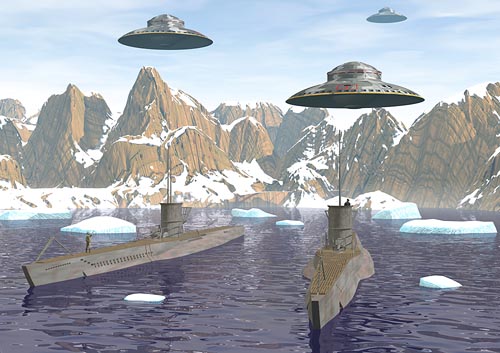
Rumors began to circulate that even
though Germany had been defeated, a selection of military personnel
and scientists had fled the fatherland as Allied troops swept across
mainland Europe and established themselves at a base on Antarctica
from where they continued to develop advanced aircraft based on
extraterrestrial technologies.
It is interesting to note that at the
end of the war the Allies determined that there were 250,000 Germans
unaccounted for, even taking into account casualties and deaths.
This would be quite a population base for a fledgling colony, and
provide the essential degree of skill, expertise, and pure manpower
for an industrial base of any sort, let alone the production of,
even by today’s standards, extremely high technology.
All Unidentified Flying Object researchers are, of
course, aware of the multitude of reports concerning sightings of
‘flying saucers’ with swastikas or iron crosses on them, ‘aliens’
speaking German, etc. Most have also heard of abductees who have
been taken to underground bases with swastika emblems on the walls,
or as in the case of noted abductee Alex Christopher, have
seen “Reptiloids” and “Nazis” working together aboard antigravity
craft or within underground bases.
Barney Hill was apparently, not
the only one to describe the so-called “Nazi” connection to
Unidentified Flying Object abductions. However, reports such as
Christopher’s and Hill’s must be taken with a rather large grain of
salt... There is a far more plausible explanation than the so-called
“reptiloids”.
Another noted example is the American Reinhold Schmidt, a man
whose father was born in Germany, and who tells in his book
“Incident At Kearney”, that he was taken on a ‘flying saucer’ on
several occasions. Schmidt states that “the crew spoke German and
acted like German soldiers”. He also stated that they took him to
the “Polar” region.
Now, one must admit that if a person were making up such a story,
why would they claim to be taken, of all places, to the pole? Of
course, one must also realize that at the time of Schmidt’s
comments, the rumors of “secret Nazi bases” at the poles were
already fairly common... After returning he was allegedly subjected
to persecution by the U.S. Government. In his defense, it must be
noted that his description of the aerial discs, as he called them,
matched pictures captured from the Germans in the final days of the
Second World War.
In 1959, three large newspapers in Chile reported front-page
articles about Unidentified Flying Object encounters in which the
crew members appeared to be German soldiers. In the early 1960s
there were reports in New York, and New Jersey, of flying saucer
‘aliens’ who spoke German, or English with a German accent. Nor, can
it be neglected to mention that in one of the most spectacular legal
cases of the Twentieth Century... the “atomic espionage” trials...
Julius and Ethel Rosenberg spoke of “warships of space.”
Since they had access to top secret
information, and, at that point, no reason to lie, what was it,
exactly, that they meant?
So... now we get to the point...
In late 1947, only months after the
famous Roswell Incident, then Secretary of the Navy James Forrestal
sent a naval task force to Antarctic including Admiral Nimitz,
Admiral Krusen and Admiral Byrd, called “Operation Highjump”. It was
touted to be an expedition to find “coal deposits” and other
valuable resources, but... the facts indicate otherwise... In
actuality they were apparently trying to locate an immense
underground base constructed by the Germans, before, during and
immediately after the Second World War, with the aid of Alien
Entities, which were described as “Aryans”.
This base was allegedly located in
Neuschwabenland, an area of Antarctica which Germany explored, and
claimed, before the outbreak of the Second World War... In fact,
Germany had done a very detailed study of Antarctic and were alleged
to have built a small underground base there before the War.
At this point, one must ask why, exactly, the United States, and, in
fact, her allies, suspected that German activity at the pole was
continuing, after the conclusion of the Second World War... The
answer, quite honestly, has nothing at all to do with Unidentified
Flying Objects... That part of the story came to light from a
completely different set of sources...
The fact is that there was plenty of
evidence, at the time, to indicate that as late as 1947, elements of
the Kriegsmarine, or German Navy, were still very much active in the
South Atlantic, operating either out of South America, or some base,
previously unsuspected, in the Antarctic. Many stories were
circulating at the time...
One of which even has a German U-boat
stopping an Icelandic whaler named Juliana in Antarctic waters, in
1947 and insisting that its captain, named Hekla, sell the U-boat
crew supplies from her available stores. In exchange for the
supplies (which had been paid for in U.S. dollars, along with a ten
dollar bonus to each member of Juliana’s crew... ) the U-boat
commander told the whaler where a large school of whales were to be
found. Hekla and his crew later found the whales in the exact
position claimed by the U-boat commander.
The presence of such boats, all late construction Type XXI and Type
XXIII U-Boats, with the “snorkel” that allowed them to make the
entire passage from Germany submerged... was no secret.
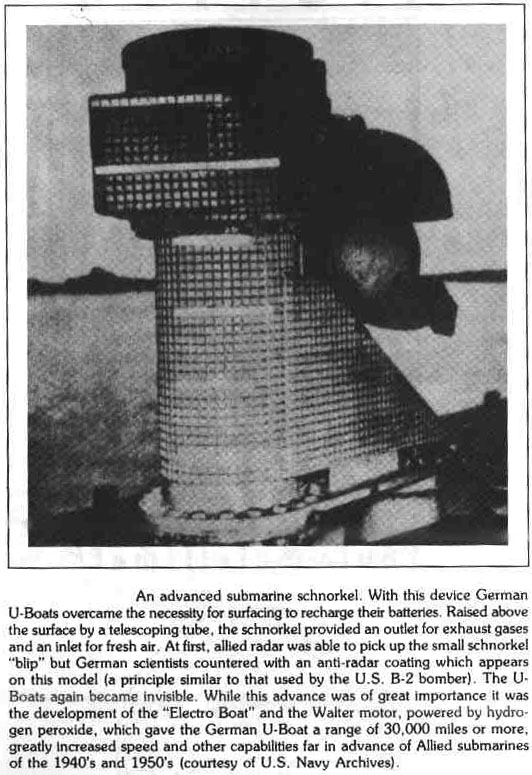
Many were thought to be operating out of
Argentina, possibly under the Argentine flag, but crewed by German
crew.
The fact that in the dying moments of
the Second World War, ten U-Boats, based in Oslofjord, Hamburg and
Flensburg, were made available to transport several hundred German
officers and officials to Argentina to found a new Reich is widely
accepted. These officers, mostly involved in “secret” projects, and
many of whom were members of the SS and Kriegsmarine, itself, sought
to escape the “vengeance” of the Allies, and continue their work,
abroad.
The U-boats were filled with their
luggage, documents and, more than likely, gold bullion, to finance
their efforts. All the U-boats departed their home ports between 3
and 8 May 1945. They were to proceed to Argentina where they would
be welcomed by the friendly regime of Juan Peron and his charismatic
wife Eva Peron. Seven of the ten of the U-Boats, based on the
German/Danish border, set off for Argentina through the Kattegat and
Skagerrak. None were ever seen again... “officially”.
It has been, however, documented that
three of the boats did, in fact, arrive in Argentina... These were
U-530, U-977 and U-1238. U-530 and U-977 surrendered to the
Argentine Navy at Mar del Plata in early July and August, 1945...
U-1238 was scuttled, by her crew, in the waters of San Matias Gulf,
off Northern Patagonia.
Seven boats are as yet unaccounted
for... and... Kriegsmarine archives, recently discovered, indicate
that a total of more than forty boats are completely unaccounted
for... all of which were late construction, state-of-the-art craft,
and could have made either Argentina or Antarctica, completely
submerged... and completely unnoticed by existing “allied”
technology of the time... for the entire duration of their crossing.
The question arises, of course, why these men would make such a
perilous crossing. It must surely be seen as a act of either
desperation or fanaticism, or both... and such men as crewed U-Boats
were neither. Nor, were the scientists and military officers who
were their passengers. The fact is, it would seem that most of those
who fled the ruin of Germany to the far South, were scientists and
engineers, and their dedication sprang from the project on which
they were working...
To understand this dedication, it is
necessary to go back, before the outbreak of the Second World War,
to an isolated section of the Bavarian Alps, It was there, in the
summer of 1938, that an Unidentified Flying Object, crewed by a
distinctly human, and Aryan appearing race, made a forced landing,
very similar to the one which was to occur, some ten years later, in
the desert, near Roswell, New Mexico, in the United States.
While the occupants of the two craft were completely unrelated, the
technology involved, seems to have been strikingly similar. Also,
the outcome of the recovery effort, undertaken by Germany, just as a
similar recovery effort was undertaken by the United States, had
strikingly different results.
The Bavarian crash of 1938, seems to have yielded an functioning, or
almost functioning and repairable (with the technology of the time)
power plant, and a nearly completely destroyed, or unrepairable
airframe.
The Roswell crash resulted in exactly the opposite... a
nearly intact airframe and a ruined power plant. Because of this,
the German research, which was to follow, took a vastly different
turn from that which was undertaken in the United States, some ten
years later... Germany needed an airframe which was capable of
supporting the “engine” (for lack of a better term), while the
United States would eventually need an “engine” capable of giving
maximum performance to the airframe.
This, of course, would explain the vast array of “experimental”
aircraft... of extremely “unique” design... to literally pour out of
the design bureaus of Messerschmidt, Focke Wulf, Fokker and a
multitude of smaller firms in the period between 1939 and 1945. The
most notable, of course, is the Sänger “Flying Wing” which was later
copied by the United States, and is, of course, the ancestor of
today’s “stealth” bomber and fighter designs... notably, the B-2
Heavy Bomber.
It is also beyond doubt that both Unidentified Flying Object
recoveries are the initial impetus for the long standing and ongoing
research in “anti-gravity” propulsion seen in work of current
aircraft manufacturers such as Boeing and Lockheed in the United
States, and PanAvia in Europe.
In any case, it was the work on “reverse engineering” the downed
Bavarian Unidentified Flying Object that was the catalyst for the
“exodus” to the South in the final days of the Second World War.
Germany was in ruins, and the research was viewed, by those
conducting it, as vital... vital enough to risk packing up all that
they had and risking a perilous submerged crossing of the Atlantic..
to an isolated experimental and research base on a frozen
continent...
Granted, by modern standards... even by
the standards of the day... U-Boats were small and cramped. They had
very little cargo capacity. Still, a tiny fleet of them... ten to
twelve boats... could easily transport the essential equipment,
making several “runs”, and serve to supply and, later re-supply the
Antarctic bastion of the research.
Speculation exists, with much to support it, that at least one of
the boats in the valiant little fleet contained the biggest prize of
all... at least one living survivor of the 1938 crash... an
Extraterrestrial... a literal Human Being... not a “Grey”... born on
a distant planet. The best evidence indicates that there were
several survivors of the crash, and that they worked, and are most
likely still working, with the original German scientists and
engineers, or their descendants, in an effort to construct a viable
“flying disc”.
These are not the “Grey Aliens” of Roswell. These beings,
biologically, completely human, are described as “Aryan” in
appearance, and completely human, although at least two to three
generations more advanced, technologically than Earth born Human
Beings. While their technology is similar to that of the Grays in
general theory, it is somewhat different, apparently, in
application.
This would tend to indicate that Earth
technology and science is, at most, only one “major breakthrough”
away from parity with the extraterrestrial cultures in question, and
also explain the “urgency” of the project, as viewed by the German
(and undoubtedly United States, as well...) scientists and engineers
involved in such research.
In any case, Operation Highjump, began... The task force of over 40
ships, included the flagship “Mount Olympus”, the aircraft carrier
“Philippine Sea”, the seaplane tender “Pine Sea”, the submarine
“Senate”, the destroyer “Bronson”, the ice breaker “Northwind”, and
other tanker and supply ships. An armed contingent of 1400 sailors,
and three dog sled teams were also on board.
The expedition was
filmed by the Navy and brought to Hollywood to be made into a
commercial film called “The Secret Land”.
It was narrated by Hollywood actor
Robert Montgomery, father of “Bewitched” star, Elizabeth Montgomery,
who was, himself, an officer in the Naval Reserve.
It seems incredible that so shortly after a war that had decimated
most of Europe and crippled global economies, an expedition to
Antarctica was undertaken with so much haste (it took advantage of
the first available Antarctic summer after the war), at such cost,
and with so much military hardware - unless the operation was
absolutely essential to the security of the United States.
At the time of the operation, the US Navy itself was being taken
apart piece by piece as the battle-tested fleet was decommissioned
with its mostly civilian crew bidding farewell to the seas forever.
The Navy was even reduced to further recruitment to man the few
remaining ships in service.
Tensions across the globe were also mounting as Russia and America
edged into a Cold War, possibly a Third World War that the US would
have to fight with “tragically few ships and tragically half trained
men.” This made the sending of nearly 5,000 residual Navy personnel
to a remote part of the planet where so much danger lurked in the
form of icebergs, blizzards and sub-zero temperatures even more of a
puzzle. The operation was also launched with incredible speed, “a
matter of weeks.”
Perhaps it would not be uncharitable to
conclude that the Americans had some unfinished business connected
with the war in the polar region. Indeed this was later confirmed by
other events and the operation’s leader, Admiral Richard Byrd,
himself.
The official instructions issued by the then Chief of Naval
Operations, Chester W. Nimitz were:
-
to train personnel and test
material in the frigid zones
-
to consolidate and extend
American sovereignty over the largest practical area of the
Antarctic continent
-
to determine the feasibility of
establishing and maintaining bases in the Antarctic and to
investigate possible base sites
-
to develop techniques for
establishing and maintaining air bases on the ice, (with
particular attention to the later applicability of such
techniques to Greenland)
-
to amplify existing knowledge of
hydro graphic, geographic, geological, meteorological and
electromagnetic conditions in the area
Little other information was released to
the media about the mission, although most journalists were
suspicious of its true purpose given the huge amount of military
hardware involved.
The US Navy also strongly emphasized
that Operation Highjump was going to be a navy show; Admiral
Ramsey’s preliminary orders of 26th August 1946 stated that “the
Chief of Naval Operations only will deal with other governmental
agencies” and that “no diplomatic negotiations are required. No
foreign observers will be accepted.” Not exactly an invitation to
scrutiny, even from other arms of the government.
Some facts, however, are well known... There were three divisions of
Operation High Jump: one land group with tractors, explosives, and
plenty of equipment to refurbish “Little America”, and make an
airstrip to land the six R-4D’s (DC-3’s), and two seaplane groups.
The R4-D’s were fitted with jet-assist takeoff bottles (JATO) in
order to takeoff from the short runway of the aircraft carrier
“Philippine Sea”.
They also were fitted with large skis
for landing on the ice field prepared for them. The skis were
specially fitted at three inches above the surface of the carrier
deck. When landing on the ice at “Little America” the three inches
of tire in contact with the snow and ice provided just enough and
not too much drag for a smooth landing.
Following its arrival at Antarctica, the force began a
reconnaissance of the continent. Byrd himself was onboard the first
of the planes to take off on 29 January 1947.
Rocket propulsion
tubes (JATO bottles) had been attached to the side of the aircraft
and the carrier was maneuvered for a 35mph run to help get the
planes airborne.
“From the vibration of the great carrier”, Byrd
later wrote, “I knew when the captain had got the ship up to about
30 knots (35 mph... maximum, full emergency speed for such a
vessel).
We seemed to creep along the deck at
first and it looked as if we would never make it but when our four
JATO bottles went off along the sides of the plane with a terrific,
deafening noise I could see the deck fall away. I knew we had made
it."
Admiral Byrd’s team of six R4-D’s were fitted with the, then, super
secret “Trimetricon” spy cameras and each plane was trailing a
magnetometer.
The aircraft flew over as much of the continent as
they could in the short three month “summer” period, mapping and
recording magnetic data. They also carried magnetometers show
anomalies in the Earth’s magnetism, i.e. if there is a “hollow”
place under the surface ice or ground, it will show up on the meter.
On the last of many “mapping” flights where all six planes went out,
each on certain pre-ordained paths to film and “measure” with
magnetometers, Admiral Byrd’s plane returned three hours late...
“Officially”, it was stated that he had “lost an engine” and had had
to throw everything overboard except the films themselves and the
results of magnetometer readings in order to maintain altitude long
enough to return to Little America. If we are to believe the
published and private accounts of what actually took place, this is
almost certainly the time when he met with representatives of the
“Aryan” Extraterrestrials, and a contingent of the German scientists
working on the
reverse engineering and construction of “flying
discs”...
Over the next four weeks the planes spent 220 hours in the air,
flying a total of 22,700 miles and taking some 70,000 aerial
photographs. Then the mission that had been expected to last for
between six to eight months came to an early and faltering end. The
Chilean press reported that the mission had “run into trouble” and
that there had been “many fatalities”.
(However... the official record, states
that one plane crashed killing three men; a fourth man had perished
on the ice; two helicopters had gone down although their crews had
been rescued and a task force commander was nearly lost.)
It is an indisputable fact that the
Central Group of Operation Highjump were evacuated by the Burton
Island ice-breaker from the Bay of Whales on 22 February 1947; the
Western Group headed home on 1st of March 1947 and the Eastern Group
did likewise on 4 March, a mere eight weeks after arrival.
In the end, the task force came steaming back to the United Sates
with their data, which then, immediately became classified “top
secret”. Secretary of the Navy (by this time, Secretary of Defense)
James Forrestal retired... and started to “talk”.... not only about Highjump, but about other things, as well... He was put in Bethesda
Naval Hospital psychiatric ward where he was prevented from seeing
or talking to anyone, including his wife... and... after a short
while he was thrown out the window while trying to hang himself with
a bed sheet.
So the story goes... It was, of course,
ruled a suicide, case closed. However, some of what he knew... about Highjump... about Roswell... and other things... did manage to
“leak”... How much is truth, how much is speculation is difficult to
tell. However, in every “myth” there is a grain of truth...
This much is certain... As incredible as it may sound, there is
considerable supporting evidence for these claims about a German
base in Antarctica... On the very eve of the Second World War, the
Germans themselves had invaded part of Antarctica and claimed it for
the Third Reich.
In fact Hitler had authorized several expeditions to the poles
shortly before WWII. Their stated objective was to either to rebuild
and enlarge Germany’s whaling fleet or test out weaponry in severely
hostile conditions. Yet, if true, all of this could have been
achieved at the North Pole rather than at both poles and been much
closer to home.
For some reason, however, the Germans
had long held an interest in the South Polar region of Antarctica
with the first Germanic research of that area being undertaken in
1873 when Sir Eduard Dallman (1830-1896) discovered new Antarctic
routes and the "Kaiser-Wilhelm-Inseln" at the western entrance of
the Biskmarkstrasse along the Biscoue Islands with his ship
Grönland
during his expedition for the German polar Navigation Company of
Hamburg. The Grönland also achieved the distinction of being the
first steamer to operate in the southern ocean.
A further expedition took place in the early years of the twentieth
century in the ship the Gauss (which became embedded in the ice for
12 months), and then a further expedition took place in 1911 under
the command of Wilhelm Filchner with his ship the Deutschland.
Between the wars, the Germans made a further voyage in 1925 with a
specially designed ship for the Polar Regions, the Meteor under the
command of Dr. Albert Merz.
Then, in the years directly preceding the Second World War, the
Germans laid claim to parts of Antarctica in order to set up a
permanent base there. Given that no country actually owned the
continent and it could not exactly be conquered as no-one lived
there during the winter months at least, it appeared to the Germans
that the most effective way to conquer part of the continent was to
physically travel there, claim it, let others know of their actions
and await any disagreements.
Captain Alfred Ritscher was chosen to lead the proposed
strike. He had already led expeditions to the North Pole and had
proved himself in adverse and critical situations. For the mission
Ritscher was given the Schwabenland; a German aircraft carrier that
had been used for transatlantic mail deliveries by special
flightboats, the famous 10 ton Dornier Super Wals since 1934.
These Wals were launched by catapult from the Schwabenland and had
to be accelerated to 93mph before they could become airborne. At the
end of each flight a crane on the ship lifted the aircraft back on
board after they landed in the sea.
The ship was refitted for the expedition in the shipyards of
Hamburg, and around one million Reichsmark, nearly a third of the
entire expedition budget - was spent on this refit alone.
The crew was prepared for the mission by the German Society of Polar
Research and as these preparations neared completion, the
organization invited Admiral Byrd to address them, which he did.
The Schwabenland left the port of Hamburg on 17 December 1938 and
followed a precisely planned and determined route towards the
southern continent. In little over a month the ship arrived at the
ice covered Antarctica, dropping anchor at 4B0 30B” W and 69B0 14B”
S on January 201939..
The expedition then spent three weeks off Princess Astrid Coast and
Princess Martha Coast off Queen Maud Land. During these weeks, the
two Schwabenland aircraft, the Passat and Boreas, flew 15 missions
across some 600,000 square kilometers of Antarctica, taking more
than 11,000 pictures of the area with their specially designed Zeiss
Reihenmess-Bildkameras RMK 38b.
Nearly one fifth of Antarctica was reconnoitered in this way and, for
the first time, ice-free areas with lakes and signs of vegetation
were discovered. This area was then declared to be under the control
of the German expedition, renamed Neu-Schwabenland and hundreds of
small stakes, carrying the swastika, were dumped on the snow-covered
ground from the Wals to signal the new ownership. Ritscher and the
Schwabenland left their newly claimed territory in the middle of
February 1939 and returned to Hamburg two months later, complete
with photographs and maps of the new German acquisition.
Now bear in mind that all of this took place before the recovery of
the Unidentified Flying Object, in the Bavarian Alps, in
1938... There is no conceivable reason, at least on the surface, for
such an intense interest in the South Polar regions... unless
something else had already transpired to make such an investigation
worthwhile... The true purpose of this expedition has never been
satisfactorily explained; there is merely a series of puzzles,
related reports and snippets of information that are no longer open
to verification. What is not open to doubt however, is that in the
decade preceding the Second World War, the Germans did almost
nothing that did not put the entire structure of the country on a
war footing.
This activity affected all aspects of German life; military,
civilian, economic, social and foreign policies, engineering,
industry etc. Given that the seizing of Neu-Schwabenland
occurred on the very eve of the war, it can only be concluded that
that the polar expedition was of major importance and significance
to the goals and development of the German nation.
Nor did activity end with the outbreak of the war... In fact, it
intensified... The South Atlantic, including South Polar waters
became quite active...
Between 1939 and 1941, well after the outbreak of war in Europe,
Captain Bernhard Rogge of the commerce raider Atlantis made
an extended voyage in the South Atlantic, Indian and South Pacific
Oceans, and visited the Iles Kerguelen between December 1940 to
January 1941.
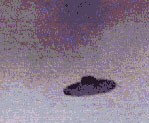
The Atlantis is known to have been visited by an RFZ-2 (the
UFO style craft which had served as a
reconnaissance aircraft since late 1940.) The ship then
adopted a new disguise as Tamesis before being sunk by HMS
Devonshire near Ascension Island, on 22 November 1941 (the Atlantis
was also known as Hilfskreuzer 16 and was, at various times,
disguised as Kasii-Maru or Abbekerk.)
Although the activities of the German ship Erlangen, under the
captaincy of Alfred Grams, do not appear to be of consequence during
1939-40, the same cannot be said of the Komet which was commanded by
Captain Robert Eyssen.
Following her passage along the Northern
Sea Route in 1940, this commerce raider operated in the Pacific and
Indian oceans, including a voyage along the Antarctic coastline from
Cape Adare to the Shackleton Ice Shelf in search of whaling vessels
during February 1941. There she met the Pinguin and supply
vessels Alstertor and Adjutant. (Komet was sunk off
Cherbourg in 1942.)
The Pinguin itself under the command of Captain
Ernst-Felix Kruder was a commerce raider that operated chiefly
in the Indian Ocean. In January 1941 she captured a Norwegian
whaling fleet (factory ships Ole Wegger and Pelagos,
supply ship Solglimt and eleven whale catchers) in about 59B0
S, 02B0 30W. One of these catchers (renamed Adjutant) remained as a
tender and the rest were sent to France. This ship also made
anchorages at the Iles Kerguelen and may have landed a party on
Marion Island.
Pinguin was sunk off the Persian
Gulf by HMS Cornwall on 8 May 1941 after she had captured 136,550
tons of British and allied shipping.
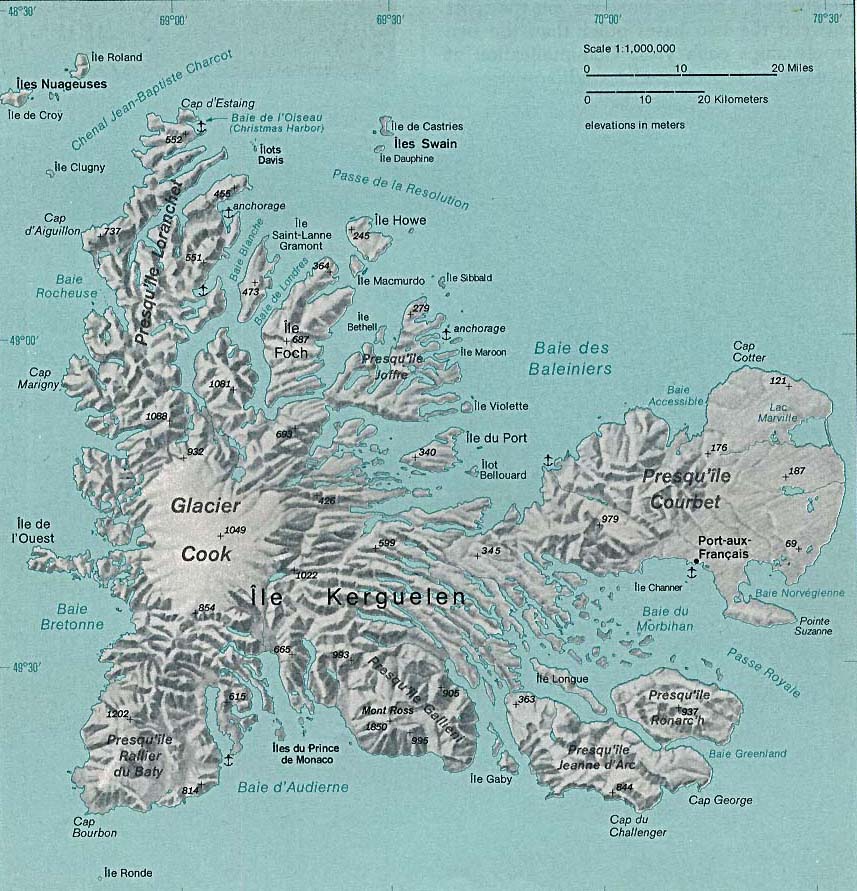
The Kerguelen
Archipelago – ideal for secret supply bases
This island of Kerguelen (named the
Most
Useless Island In the World in 1995) continued to feature
prominently in Nazi plans.
For example, in 1942 the German Navy
planned to establish a meteorological station there. In May of that
year the ship Michel transferred a meteorologist and two radio
operators with full equipment to a supply vessel Charlotte
Schlieman that went on to the island, however the orders for the
station were later counter-manned. It is interesting to note that
Kerguelen Island was also the centre of a mid 19th Century mystery.
Then entirely uninhabited, except for
seals and seabirds, British Captain Sir James Clark Ross
landed there in May 1840. He found in the snow unidentifiable
“traces of the singular footprints of a pony, or ass, being 3 inches
in length and 2 inches in breadth, having a small deeper depression
in either side, and shaped like a horseshoe.” Similar markings
appeared overnight in the Devon area of England fifteen years later
and have also defied adequate explanation.
Then in 1942 Captain Gerlach in his ship the Stier investigated
nearby Gough Island as a possible temporary base for raiders and a
camp for prisoners.
This ship activity does not appear considerable, however the level
of U-boat activity in the South Atlantic was much higher. The exact
nature and extent of how high will probably never be known, however
some insight might be gleaned from the fact that between October
1942 and September 1944 16 German U-boats were sunk in the South
Atlantic area. And... some of these submarines did appear to be
engaged in covert activities.
A fine example of this would be that of U-859 which, on 4 April 1944
at 04.40hrs, left on a mission carrying 67 men and 33 tons of
mercury sealed in glass bottles in watertight tin crates. The
submarine was later sunk on 23 September by a British submarine (HMS
Trenchant) in the Straits of Malacca and although 47 of the crew
died, 20 survived.
Some 30 years later one of these
survivors spoke openly about the cargo and divers later confirmed
the story on rediscovering the mercury. The significance being that
mercury is usable as a fuel source for certain types of aerospace
propulsion. Why would a German submarine be transporting such a
cargo so far from home?
It is not odd, at all, if one considers
the fact that aviation/avionics construction is what the Polar Base
seems to be all about...
Although Germany surrendered unconditionally to the Allies, on 8 May
1945, events after that date suggested something was happening that
did not form a part of recognized world history. Something fuelled
by a statement made by German Grand Admiral Karl Dönitz...
Dönitz (16 September 1891 b 24 December
1980) had become Commander of the German Kriegsmarine (Navy),
on 31 January 1943 and he led the German U-Boat fleet until the end
of the Second World War. He also has the distinction of briefly
becoming head of the German state for 20 days after Hitler’s death
until his own capture by the Allies on 23 May 1945. His contribution
to the mystery of post-war Antarctic activity came in a statement he
made in 1943 when he declared that a substantial portion of the
German submarine fleet had rebuilt “in another part of the world a
Shangri-La land... an impregnable fortress.”
Could he have been referring to the
alleged base in Antarctica?
Certainly there are records of continued German naval activity in
the area after the war had apparently ended. For example, on 10 July
1945, more than two months after the cessation of known hostilities,
the German submarine U-530 surrendered to Argentine authorities. The
background to this event is puzzling. It is known that the boat had
left Lorient in France on 22nd May 1944 under the captaincy of
Otto Wermuth for operations in the Trinidad area, and after
successfully rendezvousing with the incoming Japanese submarine
I-52, it headed for Trinidad before finally returning to base after
133 days at sea.
The boat’s official record states that between October 1944 and May
1945 it formed part of the 33rd Flotilla and on Germany’s surrender
Otto Wermuth’s captaincy and the submarine’s career came to an end.
Yet two months later it arrived in Rio de la Plata in Argentina and
surrendered to the authorities there on 10 July 1945.
The future may well reveal that fate of more of these submarines;
however given the French and South American reports, and the number
of missing U-boats, it may not be unreasonable to conclude that at
least some of them relocated to the South Polar area.
History also gives us further clues as to a German-Antarctica
connection, for it records that Hans-Ulrich Rudel of the German
Luftwaffe was being groomed by Hitler to be his successor. It is
known that Rudel made frequent trips to Tierra del Fuego at the tip
of South America nearest Antarctica. And...one of Martin Bormann’s
last messages from the bunker in Berlin to Dönitz also mentioned
Tierra del Fuego.
Then there are also claims about Rudolf Hess, Hitler’s best friend
who went to England and was arrested as a war criminal on 10 May
1941. Following his arrest, Hess was held in Spandau Prison in
isolation until his death. Such unique treatment is suggestive that
he had information that the Allies considered dangerous.
Indeed, in
his book Secret Nazi Polar Expeditions Christof Friedrich states
Hess,
“was entrusted with the all-important Antarctic file. Hess, himself, kept the Polar file.”
Now, granted, such information as Hess possessed, if any, would have
been complete only to the time that he took off on his solo flight
to England... but... that period... prior to 1941... would have
covered the initial recovery of the Bavarian “flying disc”, and at
the very least, the early stages of any project or projects arising
from such a recovery. It would also contain any information with
regard to any survivors of the crash, and their eventual fate(s).
Many believe that Hess, who had no part
in any of the so-called “war crimes” was deliberately kept in
Spandau Prison, for life, in an attempt to keep him quiet. It has
also been speculated that the man who died, in Spandau Prison, was,
in fact, not Hess at all... that Hess had been murdered, years
before, in an effort to keep the truth... on several highly
embarrassing matters... from getting out.
For the moment, however, let’s return to Operation Highjump...
which seems to have been an attempt to ferret out a remaining German
base on the Antarctic continent, and perhaps, to determine where,
exactly the sudden rash of Unidentified Flying Object activity of
the past eighteen months, had originated, and, exactly who/what was
behind it... There would have, of necessity, been two prerequisites
for a mission of this type.
Firstly, Operation Highjump would
have to provide evidence that the mission included a reconnaissance
of Neu-Swabenland and secondly, there would have to be an area of
the frozen continent that could allow such a base to exist
throughout the year.
Both of these criteria were met...
Both the Eastern and Western Groups of Operation Highjump had
been active around Neu-Schwabenland. So was a Russian boat that
“proved to be unfriendly”. The Eastern group were frustrated in
their efforts to make a reconnaissance of the area, despite
incredible efforts to secure photographs for later examination.
However by then,
“it was very late in the season ...
The sun had only been briefly glimpsed in the past few weeks,
but everyone could tell that the continually grey skies and
clouds were darkening daily. In another month all light would be
gone from Antarctica. The waters girdling the continent would
begin to freeze rapidly, binding unwary ships in a crushing
embrace.
Dufek [the commander] was loath to surrender. He
ordered his ships northwards away from the pack. Perhaps one or
two more flights might be possible. But on the morning of 3
March virgin ice was seen to be forming on the water’s surface
[and the] Eastern group steamed out of Antarctica.”
The Western Group, however, were to make
a remarkable discovery.
At the end of January 1947 a PBM piloted by
Lieutenant Commander David Bunger of Coronado, California, flew from
his ship, the Currituck and headed towards the continent’s Queen
Mary Coast.
On reaching land, Bunger flew west for a time, then,
coming up over the featureless, white horizon, he saw a dark, bare
area which Byrd later described as,
“a land of blue and green lakes
and brown hills in an otherwise limitless expanse of ice”.
Bunger and his men carefully reconnoitered the area before racing
back to the Currituck with news of their find. The oasis they had
discovered covered an area of some three hundred square miles of the
continent and contained three large, open water lakes along with a
number of smaller lakes. These lakes were separated by masses of
barren, reddish-brown rocks possibly indicating the presence of iron
ore.
Several days later, Bunger returned to the area, and found that the
water was warm to the touch and the lake itself was filled with red,
blue and green algae giving it a distinctive color. Bunger filled a
bottle with the water which later “turned out to be brackish, a clue
to the fact that the lake was actually an arm of the open sea”.
This is important for two reasons; warm, inland lakes connected to
the surrounding oceans would be perfect for submarines to hide
within, and similar lakes have been noted in Neu-Schwabenland,
the site of the alleged German (and suspected Alien) base.
While there is, still, no conclusive evidence of a German/Alien base
on Antarctica, It is beyond doubt that something highly unusual was
happening on, or around, the frozen continent. In general, it
appears that the probability for such a base to have existed... and
perhaps continue to exist, to this day, are rather high...
The evidence, a large volume of it, is
there for all to see...
-
The Germans explored and claimed
part of Antarctica on the very eve of the war when the vast
majority of their activity was geared towards the rebuilding
of the German economy and military infrastructure. This
activity began shortly before the recovery of the Bavarian
“flying disc”, in 1938, but picked up pace immediately
afterward.
-
There was ongoing ship and
submarine activity in the South Atlantic and polar regions
throughout and after the war had apparently ended. This
activity continued well into the 1950s, and if some accounts
are to be believed, continues to this day, with what can
only be considered U-Boat sightings, and a very high
incidence of Unidentified Flying Object sightings in the
South Atlantic and South Polar regions, including the
Southern portions of South America.
-
The US literally invaded the
continent of Antarctica, itself, with considerable naval
resources leaving mainland America exposed and vulnerable as
the world edged into the Cold War. The task force limped
home as if defeated only weeks later, and the local South
American press wrote of such a defeat. This coincided with a
substantial increase in Unidentified Flying Object
activity... generally attributed to the first major “wave”
of such activity in modern times, with an inordinate amount
of this activity taking place in the Southern Hemisphere,
particularly in South America.
-
Admiral Byrd spoke of objects
that could fly from pole to pole at incredible speeds being
based on Antarctica.
-
Hundreds of thousands of Germans
and a minimum of forty (40) U-boats were missing at the end
of the war. Documentation and eyewitness accounts prove that
at least a portion of these craft made it as far as South
America, in some cases, several months after the end of the
war in Europe.
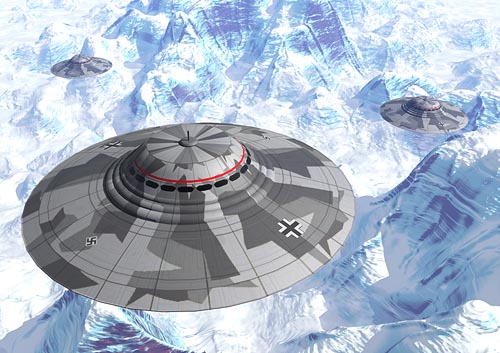
The connection between Antarctica and
the UFO phenomenon was sealed with claims made by one Albert
K. Bender who stated that he “went into the fantastic and
came up with an answer and I know what the saucers are.”
Bender ran an organization called the International Flying Saucer
Bureau (IFSB) a small UFO organization based in Connecticut, USA and he
also edited a publication known as the Space Review which was
committed to the dissemination of news about UFOs. In truth, the
organization had only a small membership and the publication
circulated amongst hundreds rather than thousands, but that its
members and readers valued it was in little doubt. The publication
itself advocated that flying saucers were spacecraft of
extraterrestrial origin.
However... in the October 1953 edition of Space Review, there
were two major announcements.
The first was headed Late Bulletin and
stated:
A source which the IFSB considers
very reliable has informed us that the investigation of the
flying saucer mystery and the solution is approaching final
stages. This same source to whom we had referred data, which had
come into our possession, suggested that it was not the proper
method and time to publish the data in 'Space Review'.
The second announcement read “Statement
of Importance":
The mystery of the flying saucers is
no longer a mystery. The source is already known, but any
information about this is being withheld by order from a higher
source. We would like to print the full story in Space Review,
but because of the nature of the information we are very sorry
that we have been advised in the negative.
The statement ended in the sentence :
We advise those engaged in saucer
work to please be very cautious.
These announcements were of little
significance in and of themselves.
Bender’s publication was
considered “fringe”, at best, even at the time... However... what
gained them wider attention was the fact that immediately after
publishing this October 1953 issue, Bender suspended further
publication of the magazine and closed the IFSB down without any
further explanation.
This is completely consistent with the
“prudent” approach, shown by many who have been “gently” warned to
“cease operations” by
the Majestic 12 Group and other
agencies involved in “keeping a lid” on any real investigation into
the Unidentified Flying Object phenomenon.
Bender might very well have known “what the flying saucers” were, at
least a portion of them... but he later revealed in a local
newspaper interview that he was keeping his knowledge a secret
following a visit by three men who apparently confirmed he was right
about his Unidentified Flying Object theory, but put him in
sufficient fear to immediately close down his organization and cease
publication of the journal.
It has been argued that the story of being visited by three
strangers and being warned off was a front to close a publication
that was losing money, however the fact that Bender had been “scared
to death” and “actually couldn’t eat for a couple of days” was
verified by his friends and associates. It is also widely known that
such “stories” are often spread by the United States, and other
governments to discredit those who might just have the truth, or at
least a portion of it.
In 1963, a full decade after his visit from the three strangers,
Bender was seemingly prepared to reveal more of his story in a
largely unreadable book entitled Flying Saucers and the Three Men
in Black. The book was scant on facts, however, it described
extraterrestrial spacecraft that had bases in Antarctica.
This was apparently the truth Bender was terrorized into not
revealing.
Bender also provided images of the
saucers he was aware of. He produced drawings of Unidentified Flying
Objects that he was aware of... not saucers, as were the common
depictions of the time, but rather “flying wings” which showed three
bubble-like protrusions on the underside, reminiscent of the German
designed
Haunebu II (which was allegedly
only in the “design stage” at the end of the Second World War)
alongside a cylindrical, cigar shaped object.
|
Ernst Zündel was NOT a
'Paperclip Scientist':
I realized that North Americans were not interested in
being educated. They want to be entertained. The book
was for fun. With a picture of the Führer on the cover
and flying saucers coming out of Antarctica it
was a chance to get on radio and TV talk shows. For
about 15 minutes of an hour program I'd talk about that
esoteric stuff.
Then I would start talking
about all those Jewish scientists in concentration
camps, working on these secret weapons. And that was my
chance to talk about what I wanted to talk about.
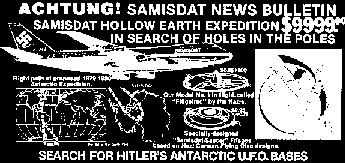 |
Ernst Zündel, a German scientist turned author (known for his
internet “ZGrams”) who had entered the US under
Operation Paperclip, a United
States Army/CIA program to bring German scientific talent into the
United States in spite of any so-called “war crimes” which they were
alleged to have committed... at the end of the war and who worked at
Wright Field (later Wright Patterson AFB where the Roswell debris
were eventually housed), also made claims about the nature of the
activity in Antarctica.
In the 1970s Zündel’s book UFOs: Nazi Secret Weapons? made the claim
that at least some Unidentified Flying Objects were German secret
Weapons which were developed during the Second World War, and that
some of them had been shipped out towards the end of the war and
hidden at the poles.
Publication of the book coincided with a
tidal wave of renewed interest in all things paranormal... coming on
the heel of what was to be the last major Unidentified Flying Object
“wave” of the Twentieth Century, and Zündel was a guest on to
countless talk shows where he shared his views on spaceships, free
energies, electromagnetism, emergent technologies and some of the
positive contributions made by the Germans in these fields.
Zündel, who was one of the first of the “revisionist” historians of
the Second World War, was actually only really interested in
promoting his holocaust theory, described in his book
Did Six
Million Really Die? However, he found that his
Unidentified Flying
Object and
Hollow Earth ideas proved a greater attraction to
television producers. The idea seized hold of the popular
imagination and took on a life of its own. Zündel’s publishing
company, Samisdat, started to make a name for itself by issuing
newsletters and books on the subject. An expedition to Antarctica
itself was even proposed to seek out Hitler’s UFO bases there.
The fact is that such claims would have died out had they not been
based on at least some real events...
Now, keep in mind that South America has always been a “hotbed” of
Unidentified Flying Object activity. Many of the reports coming out
of the area are unverified, and unverifiable... However, many have
credence. The claims that something extremely unusual was taking
place around the foreboding reaches of the frozen continent took a
major leap forward in the 1960s when the Argentine Navy was charged
with the official investigation into strange sightings in the sky.
A 1965 official report prepared by Captain Sanchez Moreno of
the Naval Air Station Comandante Espora in Bahia Blanca
stated that,
“Between 1950 and 1965, personnel of Argentina’s Navy
alone made 22 sightings of Unidentified Flying Objects that were not
airplanes, satellites, weather balloons or any type of known
(aerial) vehicles. These 22 cases served as precedents for
intensifying that investigation of the subject by the Navy.”
Following a series of sightings at Argentine and Chilean
meteorological stations on Deception Island, Antarctica, in June and
July 1965, Captain Engineer Omar Pagani disclosed at a press
conference that,
“Unidentified Flying Objects do exist. Their
presence in Argentine airspace is proven”.
The report went on to state, however,
“their nature and origin are unknown
and no judgment is made about them”.
More details of these UFO sightings were
given in a report in the Brazilian newspaper O Estado de Sao Paulo
in its 8th July 1965 edition.
“For the first time in history, an
official communiqué has been published by a government about the
flying saucers. It is a document from the Argentine Navy, based
on the statements of a large number of Argentine, Chilean and
British sailors stationed in the naval base in Antarctica.
The communiqué declared that the personnel of Deception Island
(left) naval base saw, at nineteen hours forty minutes on 3
July, a flying object of lenticular shape, with a solid
appearance and a coloring in which red and green prevailed and,
for a few moments, yellow. The machine was flying in a zig-zag
fashion, and in a generally western direction, but it changed
course several times and changed speed, having an inclination of
about forty-five degrees above the horizon. The craft also
remained stationary for about twenty minutes at a height of
approximately 5,000 meters, producing no sound.
The communiqué states moreover that the prevailing
meteorological conditions when the phenomenon was observed can
be considered excellent for the region in question and the time
of year. The sky was clear and quite a lot of stars were
visible. The Secretariat of the Argentine Navy also states in
its communiqué that the occurrence was witnessed by scientists
of the three naval bases and that the facts described by these
people agree completely.”
Practically everyone in the “UFO
Community” is aware that in March 1950 Commodore Augusto Vars Orrego
of the Chilean Navy shot still pictures and 8mm movie footage of a
very large cigar shaped flying object that hovered over and
maneuvered about in the frigid skies above the Chilean Antarctic.
The photos and the report of Orrego’s
sighting have, quite literally, been seen by millions over the half
century since he saw, and photographed the objects. Orrego stated,
“during the bright Antarctic night, we saw flying saucers, one above
the other, turning at tremendous speeds. We have photographs to
prove what we saw .”
There have, of course, been numerous other
Chilean sightings.
During January 1956 another major Unidentified Flying Object “event”
was witnessed by a group of Chilean scientists who had been flown by
helicopter to Robertson Island in the Wendell Sea to study geology,
fauna and other features.
This experience was the subject of a later
article entitled A Cigar-Shaped UFO over Antarctica.
“At the beginning of January 1956,
during a period of stormy weather, the party suddenly became
aware of something which, in other circumstances, could have
been very grave for them. This was that their radio had
mysteriously ceased to function. This was not too worrying a
disaster in so much as it was firmly settled that the helicopter
would return to take them off again on January 20.”
One of the scientists, a doctor, was in
the habit of getting up in the night to observe anything of
meteorological interest, but another of the group, a professor, did
not like to be disturbed. However on the night of 8 January 1956,
the Doctor decided to wake the professor.
He pointed upwards, almost overhead.
Still in a bad temper due to being disturbed, the professor looked
as directed, and beheld two,
“metallic, cigar-shaped objects in verticular positions, perfectly still and silent, and flashing
vividly the reflected rays of the sun”.
Just after 7.00am, two other
members of the party, an assistant and a medical orderly joined the
two men.
The group watched the two craft.
“At
about 9.00am object No. 1 (the nearest to the zenith) suddenly
assumed a horizontal posture and shot away like a flash towards the
west. It had now lost its metallic brightness and had taken on the
whole gamut of visible colors of the spectrum, from infrared to
ultra-violet.
The report of the sighting went on to say...
“Without slowing down it performed
an incredible acute-angle change of direction, shot off across
another section of the sky and then did another sharp turn as
before. These vertiginous maneuvers, the zig-zagging, abrupt
stopping, instantaneous accelerating, went on for some time
right overhead, the object always following tangential
trajectories in respect to the Earth and all in the most
absolute silence”.
The demonstration lasted about five
minutes.
Then, according to the witnesses, the object returned and
took up position beside its companion in almost the same area of the
sky as before.
Then, it was the turn of No. 2 to show
its paces and do a convoluted, zigzagging dance across the sky.
Shooting off towards the east, it performed a series of ten
disjointed bursts of flight, broken by abrupt changes of direction,
and marked by the pronounced color changes when accelerating or
stopping. After about three minutes, object No. 2 was observed to
resume its station near its companion, and return to its original
solid and metallic appearance.
Due to the nature of their mission, the group had with them two
Geiger-Miller counters of high sensitivity, one of the auditory and
the other of the flash-type. When the two objects had finished their
dance and reassumed their stations in the sky, someone discovered
that the flash-type Geiger counter now showed that radioactivity
around them had suddenly increased 40 times... far more than enough
to kill any organism subjected long enough to it. The discovery
greatly increased the anxiety felt by the four men.
Although they had no telescopic lens, they did have cameras with
them, and managed to take numerous photographs of the objects, both
in color and black and white. The report does not state what became
of these photographs, but it is safe to assume that they are in the
possession of the Chilean Government, and there is no reason to
assume that they have not been shared with that of the United
States, as well as others.
Of course... no names are given in this report, but... it has the
ring of truth, and is consistent with any number of similar
sightings... Would that we knew their names! It is one of the
exasperating facts of Unidentified Flying Object research that so
many of the South American and South Atlantic sightings are
attributed to “anonymous sources” or the names of the witnesses
involved, have been expunged from the “official” records.
So many of the witnesses being cited
would be, with reference to their stated credentials, credible
sources, but because of the practice of expunging names from records
which might fall into “public hands” are practically impossible to
trace. The absence of names... in many, if not most cases
deliberately expunged from official reports... simply lends to an
aura of “unbelievability”, even though it is a common practice,
especially in most countries.
Yet another documented account of a UFO sighting over Antarctica is
by Rubens Junqueira Villela, a meteorologist and the first
Brazilian scientist to participate in an expedition to the South
Polar region, and now, a veteran of eleven expeditions to Antarctica
(two with the US Navy, eight with the Brazilian Antarctic Program
and another on the sailing ship Rapa Nui).
While on board the US Navy icebreaker
Glacier, which had set sail from New Zealand at the end of January
1961, Villela claims that he witnessed a UFO event in the skies over
Antarctica which he immediately recorded in his diary, even
including the emotions felt by all those involved. On 16 March 1961,
after a fierce storm had forced the expedition to retreat to
Admiralty Bay in the King George Isles, “a strange light suddenly
crossed the sky, and everyone started to shout”.
Speculation went wild. Some thought the object to be an incoming
missile. Others thought it to be a meteor.
The excitement was widespread and
growing.
“Trying to describe the light which
appeared over Almirantado Bay” he told interviewers, later,
“wasn’t easy b& I wrote in my diary: Positively the colors, the
configuration and contours of the object, as a bodied light,
with geometric forms, did not seem to be from this world, and I
did not know what could possibly reproduce it”.
The object, he went on to report, was
“multi-colored”, and had a luminous, oval-shaped body. It left,
behind it, a “long tube-like orange/red trail”.
Allegedly, it split
into two pieces, as if it had exploded. Then, each part shone even
more intensively, with white, blue and red colors projecting V
shaped rays behind it. They quickly moved away and could be seen 200
meters above the ground b& According to the witnesses, the entire
display was completely silent.
The US Navy officially registered the incident as “a meteor or some
other natural luminous phenomenon” according to the report submitted
by the Glacier’s captain, Captain Porter. However, this is a common
practice, and has been, ever since the inception of the Unidentified
Flying Object cover-up, under the auspices of the Majestic 12 group.
This policy of “official denial” and
“logical explanation” no matter how far fetched, would seem, has
been followed by all branches of the United States Government since
the first days after the Roswell Incident, in July 1947. It
certainly applies to any sightings or alleged sightings in and
around Antarctica...
Villela, on the other hand, easily dismissed the official line.
“How could they mistake a meteor
with an object carrying antennae, completely symmetrical and
followed by a tail without any sight of atmospheric
disturbance?”
According to most “official” sources...
and certainly according to world renowned skeptic and self-styled
debunker, Phillip Klaus, this particular episode is a classic
example of plasma, however the late meteorologist, James McDonald
argued that the highly structured nature of the object and the low
cloud overcast present at about 1500 feet were not compatible with
Klaus’s hypothesis.
The list of sightings in the South Atlantic area is practically
endless. It is, and has been, particularly since the end of the
Second World War, one of the most active areas on earth with respect
to Unidentified Flying Object activity. Another classic sighting
took place on 16 January 1958 when the Brazilian naval vessel
Almirante Salddanha was escorting a team of scientists to a weather
station on Trindade Island. As the ship approached the island (or
rather an outcrop of rock) an Unidentified Flying Object reportedly
flew low, over the water, past the ship, circled the island, then
flew off in front of dozens of witnesses.
One of the witnesses to this particular event, the expedition
photographer, took a number of photographs of the object. Later, the
film was handed over to the military by the Captain. Amazingly,
after the initial analysis, the Brazilian government released the
film stating that they were unable to account for the images.
Why did the United States Government, in late 1947, only months
after the famous Roswell Incident, send a naval task force to
Antarctic including Admiral Nimitz, Admiral Krusen and Admiral
Byrd,
called “Operation Highjump”. As we observed earlier, the operation
was said to be an expedition to find “coal deposits” and other
valuable resources, but... the facts indicate otherwise...
In actuality, there seems to be no doubt
that they were trying to locate an immense underground base
constructed by the Germans, before, during and immediately after the
Second World War, with the aid of Alien Entities which were
described as “Aryans”. This base, allegedly located in an area that
the Germans called “Neuschwabenlandt”... an area of Antarctica which
Germany explored, and claimed, before the outbreak of the Second
World War... was thought to hold “flying objects which could fly from
Pole to Pole in a matter of minutes”...
For years, rumors have circulated as to why German submarines...
U-Boats... would operate in South American and Antarctic waters long
after the end of the Second World War, in Europe.
Some have said that the boats spirited
away such notables as Adolf Hitler and Martin Bormannn... both of
whom can be demonstrated to have died in Berlin at the end of the
war. the death... and physical remains of both men have been
verified beyond doubt, the latter with very recent DNA testing. Thus
neither of them escaped via U-boats to South America. The fact is,
Wolfgang Eisenmenger, a forensic science professor at Munich
University, conducted the DNA testing of Bormann’s remains. He seems
to have done the work for the Frankfurt justice officials.
He also had Bormann’s dental, medical,
and fingerprint records. Bormann’s children (or a distant family
member, details a bit fuzzy) provided the blood for the DNA match
which was proven conclusive, i.e. that the body was of Martin
Bormann. The cause of death was deemed to be self inflicted
poisoning. Adolf Hitler, of course, died in his Bunker in Berlin, of
poison... and a self inflicted gunshot.
Everyone has heard stories of vast amounts of gold or other
valuables being “smuggled” out of Germany in the last days of the
war... secreted away to South America... to support so-called
“criminals” abroad. So far, none of those stories has shown any sign
of merit. If they were so, then men such as Eichman would not have
worked on the assembly line in a Volkswagen plant. Müller would not
have run a chicken farm, and Mengele would not have been dependent
upon the generosity of his wealthy family.
There is a story floating around that this said U-boat commander
worked on some highly classified US National Secrets after the war,
and that his boat was operating in the far South... He was reported
to have been a commander of a VIIC or IXC U-boat in the Atlantic
during the war, named Otto Schneider. This theory is also easy to
disprove...
There simply was no U-Boat commander by
that name in the Kriegsmarine (German Navy). Only two commanders
with that last name saw service in the war; Herbert Schneider who
died while in command of U-522, and Manfred Schneider only commander
the small XXIII boat U-4706 for the last 3 months of the war, and
never left his home port. This story is just that, a story.
The fact is, Unidentified Flying Object researchers are well
aware of strange sightings of ‘flying saucers’ with swastikas or
iron crosses displayed on them.
They are also well aware of ‘aliens’
speaking German, and have also heard of abductees who have been
taken to underground bases with swastika emblems on the walls, or as
in the case of one abductee... Alex Christopher... who claims
to have seen “Reptiloids” and Germans working together aboard
antigravity craft or within underground bases.
-
Is this what America feared?
-
Is it a secret Antarctic
facility where these experiments and developments continued?
-
What Operation Highjump was
actually looking for?
-
Is this secret, among others,
the one that cost James Forrestall his life?
-
Did an unrecorded, three hour
long meeting with a group of German scientists and engineers
and “Aryan” Extraterrestrials in the frozen wastelands near
the South Pole cost Admiral Byrd his life?
-
Is this the origin of the
“warships of space”, that the Rosenberg’s mentioned in the
very shadow of the electric chair?
One thing is certain... The United
States did not “invade” Antarctica, at the end of a World War and
the very beginning of a Cold War... using a disproportionate share
of it’s diminishing fleet... for “exploration” purposes.
If they were looking for something, they
surely knew what it was they were looking for... and... a
“scientific” expedition does not go forth prepared for WAR...
The map of Neu Schwabenland that cannot be exhibited in
Germany, on penalty of imprisonment...
A Secret U.S. Post Office operated in Antarctica 1946-1948 causing
speculation about the real reason behind two concurrent U.S.
expeditions...
Finn Ronne was a Norwegian immigrant who later joined the United
States Navy and was a member and officer in Admiral Byrd's earlier
expeditions to Antarctica. In 1946-8, he led a privately-financed
expedition to Antarctica, following upon the heels of
Operation Highjump.
Ronne's
expedition was to the Marguerite Bay area, where he reoccupied
Byrd's 1939 Base. One of the most important results of this
expedition was a showing that the Antarctic Peninsula was connected
to the rest of Antarctica, thus solving one of the last great public
mysteries of the continent.
Writing in his book entitled "Antarctic Conquest", he stated:
Although no one knew it, I had been
operating a United States Post office too, but for reasons of
state (emphasis added) had been compelled to keep it secret.
Secrecy seems to be in no scarcity as it
relates to several Antarctic expeditions; perhaps in no small way
due to a continued concern that the Nazis had a remnant left in
Antarctica from their infamous 1938-9 "New Schwabenland"
colonization of Antarctica.
The web is abundant with sites setting forth information about
suspected and actual German involvement in Antarctica possibly
dating back even to the late 1800's. It does make one wonder if
there were in fact, covert or as they say today, "black-ops" reasons
for one or more of the Byrd Expeditions (including Operation Highjump for this discussion) as well as the private expedition of
Captain Ronne.
Many online sources are available with information concerning what I
have dubbed the "Byrd Conspiracy", which was not a conspiracy by
Admiral Byrd, rather what may have been an apparent conspiracy by
the government to keep particular information that he had uncovered
during Operation Highjump as a secret. I am not passing judgment at
this time, as I am still investigating the whole thing to my
satisfaction.
However, lending credence to this conspiracy theory is the
observation that Admiral Byrd does in effect seem to "disappear"
from public view shortly after his return from Operation Highjump in
1947-- until approximately 1955 when he organized Operation Deep
Freeze I, and he was reported to have been hospitalized (in a mental
ward) shortly after his return in 1947.
This forced hospitalization is said to
have came upon the tails of Byrd having made some remarkably candid
comments (which included what smacked of being a description of a
UFO) to a South American newspaper about what he had found during
Operation Highjump. His disappearance from the scene after his
arrival back in the states, would make it appear he may have been
promptly squelched! Remember that this time period coincided roughly
with the Roswell UFO sightings.
Operation Highjump would have been
first, early in 1947, and then Roswell to follow in the summer of
1947.
This was a situation that was the last
thing the government would have wanted, another military official
(in this case a quite prominent and popular man who had spent years
criss-crossing the United States giving lectures and whose word
would have been quite respected and accepted) who apparently
reported having seen/and or believing in UFOs!!
NOTE: If Op HJ had
continued to its full expected duration of six to eight months,
they would have still been in Antarctica at the time of Roswell.
The expedition headed back to the U.S. in early 1947, well short
of its expected ending. Some would say "limped back", after
suffering great losses of personnel and equipment. The official
record only sets forth a limited loss of life and aircraft, but
conspiracists feel the record has been doctored or we are not
being told the full story.
Contrast this lack of public
accessibility after Operation Highjump, to the previous
well-known availability of Admiral Byrd in the period following his
first two Antarctic Expeditions, where there are documented
philatelic items from cities all over the country serving as
commemorations of where Byrd visited lecturing to the public about
his travels in Antarctica. That Byrd loved to travel and lecture
about his polar explorations is quite evident.
The polar regions and his expeditions were his very reason for
existence; he had said from the time he was a child that he felt
destined to be a polar explorer. He had a passion for all things
polar, especially exploration, that could scarcely be contained.
Operation Highjump was at least as
important in many respects, it would appear, as his previous
expeditions... so,
-
Where was he after his return?
-
Where did he go?
-
Was he locked away so he
couldn't share the story of what he really had found in
Antarctica?
-
As some theorists suggest,
during Operation Highjump, did he encounter and engage Nazi
forces operating from bases that lodged advanced aircraft
with advanced propulsion systems?
Many think so, and I am beginning to see
some curiosities about many aspects of Operation Highjump and now,
perhaps even with Ronne's Expedition.
The little tidbit mentioned above that Ronne forked us in his book,
only begins to tell us why the Oleana Base, Antarctica postmark is
one of the rarest polar cancels that exist. With this being the
first American post office established on the Antarctic continent,
it is a shame that the cancel was not used more often. Is there
perhaps a larger reason why this post office was kept secret? We do
know that many countries, including Britain, had concurrent secret
bases and or expeditions in the same general time period, notably
Port Lockroy on the Antarctic peninsula.
Port Lockroy was part of a top secret
World War II British expedition called Operation Tabarin.
Operation Tabarin was the beginning of Britain's permanent
presence on the Antarctic continent, and was built to serve as a
southern outpost and to keep an eye on suspected Nazi presence on
the ice. In a 2001 BBC interview, one of the last remaining
survivors of that secret expedition, Gwion Davies, noted that
the posting of mail from their secret base was a way of their laying
claim to, or establishing that section of Antarctica as British
sovereign territory.
In other words, just as the Nazis are
known to have dropped metal dart/markers with the Third Reich
swastika emblem over a large area of Antarctica during their
expedition in 1939, to act as a laying of a claim; for any country
(such as Britain) to have a post office that actually accepted and
postmarked mail definitely shows an intention on their part of not
only
establishing a base, but of staying.
While the United States did not then, and does not now, recognize
any country as having specific territorial claims upon Antarctica,
for Ronne to have allowed his expedition members to have open
mailing of letters from Oleana Base would have served a
similar purpose as with Port Lockroy, but for some reason, he would
not allow that to be done.
Why?
Some mail did escape, and other mail
from members of the Ronne Expedition is known to have been posted
from nearby British bases. The posting of mail often serves a
geo-political purpose in addition to the simple fact it carries mail
back home to loved ones; and it is a great curiosity to many polar
philatelists and followers of Antarctic history that it was not done
in this instance.
The full story about the existence of
the post office (as well as even greater secrets?) may have passed
with Captain Ronne.
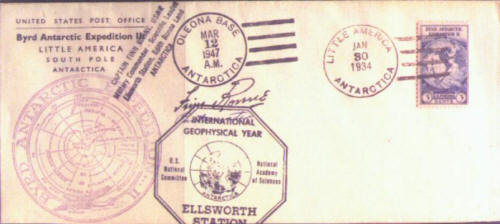
The "Holy Grail"
of Antarctic Covers
The Oleana Bay covers are
most commonly seen with a date of March 12, 1947, which was the
date the expedition arrived at Marguerite Bay, Antarctica.
In this instance, the cover
illustrated above is extraordinary in that it is on a printed
envelope from the Byrd II Antarctic Expedition, postmarked with
the less common hand cancellation from that mission; then repost
marked at Oleana Base in 1947, with the addition of
Captain Ronne's "corner card" and the IGY Ellsworth Station
octagonal cachet, and the best part of all, Ronne's signature in
which he adds the word "Postmaster", rounding it out to make a
splendid cover!
A cover like this would fare
extremely well in a polar auction. I would go so far to term it
as the "Holy Grail" of a polar collection; only very few covers
I can think of would be more collectable, in my opinion.
|








